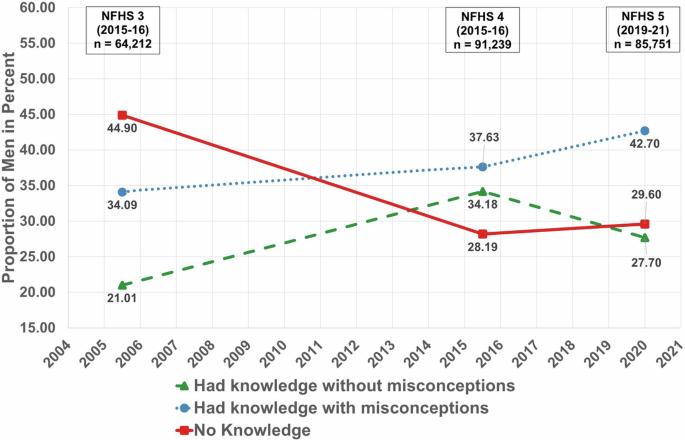Nationwide surveys of awareness of tuberculosis in India uncover a gender gap in tuberculosis awareness
IF 5.4
Q1 MEDICINE, RESEARCH & EXPERIMENTAL
引用次数: 0
Abstract
Tuberculosis remains a major challenge in India, with an estimated 2.69 million cases each year. Although men are more affected than women, gender differences and related factors affect awareness of tuberculosis and thus impact tuberculosis diagnosis and access to treatment. Understanding the gender-specific needs and complexities when diagnosing and treating tuberculosis is essential to manage cases in India. We undertook a comparative study using data from three National Family and Health Surveys (NFHS), specifically NFHS-3, NFHS-4 and NFHS-5. We investigated the prevalence and gender disparity in awareness about tuberculosis, and associated factors, using regression analysis. Most men and women surveyed are between the ages of 15 and 19. Across the surveys, the proportion of men and women who are unaware of spreading of tuberculosis decreases from 44.9% during NFHS 3 to 29.6% during NFHS 5. However, the prevalence ratio of men to women with no knowledge about modes of transmission of Tuberculosis increases from 0.92 during NFHS 3 to 0.98 during NFHS 5. Higher odds with younger age (NFHS 5, aOR: 1.07 (1.01–1.13)) and rural residency (NFHS 5, aOR: 1.12 (1.06–1.18)), and lower odds with unmarried marital status (NFHS 5, aOR: 0.92 (0.86–0.98)) are noteworthy associations. Women and men have differences in knowledge. Gender disparity associated with awareness about tuberculosis in India is observed across all three nationwide surveys. Being aged fifteen to nineteen years and residing in rural area are risk factors. Being unmarried is a protective factor for women, but not for men. Lack of awareness of the spread of tuberculosis may be an important factor contributing to the current burden of disease. We used datasets from three rounds of the National Family Health Survey conducted in India to determine the proportion of men and women who knew how tuberculosis spreads. Using a predictive model, we showed that misconceptions are more common among both men and women. For women, younger age and living in rural areas were risk factors for lack of awareness, which was not the case for men. Such differences may represent a barrier to reducing the burden of disease. These findings can be used to develop gender-specific, comprehensive people awareness programs to raise awareness about tuberculosis. Sobagaiah et al. investigate the gender gap in awareness about how tuberculosis is transmitted 2 across three national family health surveys in India. Regression modelling shows variation in 3 awareness between men and women at a national level.

印度在全国范围内开展的结核病认知调查发现,在结核病认知方面存在性别差距。
背景:结核病仍然是印度面临的一大挑战,估计每年有 269 万病例。虽然男性患者多于女性,但性别差异和相关因素会影响人们对结核病的认识,从而影响结核病的诊断和治疗。在诊断和治疗结核病时,了解不同性别的需求和复杂性对于管理印度的病例至关重要:我们利用三次全国家庭与健康调查(NFHS)的数据进行了比较研究,特别是 NFHS-3、NFHS-4 和 NFHS-5。我们使用回归分析法调查了结核病的流行情况、对结核病认识的性别差异以及相关因素:大多数接受调查的男性和女性年龄在 15 至 19 岁之间。在各次调查中,不知道结核病传播的男女比例从 NFHS 3 的 44.9% 下降到 NFHS 5 的 29.6%。 但是,不知道结核病传播方式的男女比例从 NFHS 3 的 0.92 上升到 NFHS 5 的 0.6%。值得注意的是,年轻(全国家庭健康状况调查 5,aOR:1.07(1.01-1.13))和农村居民(全国家庭健康状况调查 5,aOR:1.12(1.06-1.18))的几率更高,未婚婚姻状况(全国家庭健康状况调查 5,aOR:0.92(0.86-0.98))的几率更低。女性和男性在知识方面存在差异:在印度进行的所有三次全国性调查中,都观察到了与结核病认知相关的性别差异。年龄在 15 至 19 岁之间和居住在农村地区是风险因素。未婚对女性来说是一个保护因素,但对男性来说不是。
本文章由计算机程序翻译,如有差异,请以英文原文为准。
求助全文
约1分钟内获得全文
求助全文

 求助内容:
求助内容: 应助结果提醒方式:
应助结果提醒方式:


